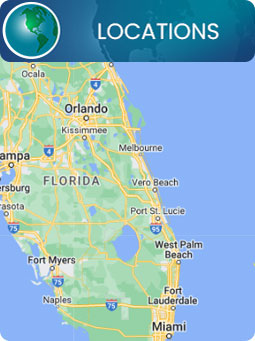Laser Rhizotomies Specialist Q&A
Laser Rhizotomy is a minimally invasive procedure that removes the sensory nerves that generate pain. These are the nerves that communicate to the brain that your back hurts. The laser effectively breaks that link. Without transmission, there is no suffering. The process is simple, quick, bloodless, outpatient, and completely safe. Talk with Dr. Michael S. Slobasky, DO, DABPMR, and his team at Global Neuro & Spine Institute to see if a rhizotomy is right for you. For more information, contact us today or schedule an online appointment. We have convenient locations to serve you in Orlando FL, Jensen Beach FL, Malabar Palm Bay FL, Atlantis FL, Fort Pierce FL, Winter Park FL and Plantation, FL.


Table of Contents:
Are Rhizotomies permanent?
What is the success rate of a rhizotomy?
How long do Rhizotomies last?
What kind of doctor performs a rhizotomy?
How many times can you have rhizotomy?
There are different types of rhizotomies available, all of which work to destroy the nerve fibres that are responsible for signalling specific pain that is being experienced, resulting in significantly less pain being experienced due to chronic pain or abnormal nerve activity. Common reasons patients will get a rhizotomy includes if they are experiencing neck or back pain from arthritis, if they have degenerative spine conditions such as spinal stenosis, or if they are experiencing herniated discs.
Rhizotomies are not able to provide permanent results, but it is common to experience substantial pain relief that last anywhere from 6 months to 2 years, with many patients being able to enjoy the results for even longer. The procedure is very effective at essentially killing the nerve fibers that are responsible for experiencing the pain, but these nerves will eventually grow back to the point of returning to the previously experienced levels of pain. The good news is that this procedure provides fast results and can be repeated, when necessary, in those who have found success from the specific treatment.
While many patients will be able to experience compete pain relief that lasts for multiple years, there is a chance of a small percentage of patients who do not experience any significant pain relief following the rhizotomy or who achieve the desired results but that the relief does not last for as long as expected. There are several different types of rhizotomies depending on the location and severity of the pain that is being experienced, with facet joint rhizotomies having a success rate of 70% to 80% and endoscopic rhizotomies having a success rate of over 90%. Your rhizotomy provider will work with you to determine if a rhizotomy will prove beneficial for your pain or if there are more effective options that should be explored to treat your specific case.
Regardless of the type of rhizotomy that is chosen for your pain relief, the goal will always be to destroy the nerve fibers that are causing the pain, which provides long-lasting results for the majority of patients. This timeline will vary from patient to patient, providing the pain relief within 4 to 6 weeks after the procedure, and lasting for at least 6 months but will last for several years for many patients. The procedure can be redone in those who have found significant relief from their pain but who want the results to be sustained for longer. The pain will likely start to return as the nerve gradually heals itself, so the procedure can be redone as soon as the nerves have healed to the point of causing significant pain once again.
A rhizotomy is a very precise minimally invasive procedure that requires the expertise of very skilled surgeons who have experience working with the nervous system and spinal cord. A laser rhizotomy is not considered to be a surgical procedure and can be performed by a non-operative spine surgeon (also known as a physiatrist), or by a pain specialist that has specific training in the procedure. Surgeons who have specialized in the spine are also qualified to perform rhizotomies. Our team of highly qualified medical staff here at Global Neuro & Spine Institute contains a variety of skillsets with specializations in the spinal cord, nervous system, and treatments for pain relief, making our practice an incredible option for anyone who wants to learn more about receiving a rhizotomy or other pain reliving procedure.
Since the pain relief following a rhizotomy gradually dissipates as the nerve fibres heal, it is very common for patients to opt to continue receiving the procedure when it has proven to offer substantial pain-relieving results. As long as the procedure is working for the individual patient, there is no limit to how many times they can have the procedure repeated. It is very common for patients to have a regular schedule to receive the procedure every 6 to 8 months to ensure that it can be redone before the nerve fibres have healed very much so that they are experiencing as little pain as possible in between treatments. The amount of time that each individual can go before experiencing pain again will vary, so it is up to the specialist that is providing the procedures and the patient to determine a good schedule that only has treatment as frequently as necessary.
A rhizotomy can be used to treat a variety of chronic pain conditions. Rhizotomies are typically reserved as the last option for pain treatment if alternative treatments, such as pain medication and physical therapy, have failed. Many people who choose to have a rhizotomy find it beneficial. If you are considering Laser rhizotomy, consult with our specialists for a proper consultation. For more information, contact us or schedule an appointment online. We serve patients from Orlando FL, Conway FL, Edgewood FL, Jensen Beach FL, Ocean Breeze FL, Rio FL, Malabar Palm Bay FL, Melbourne FL, Atlantis FL, Palm Springs FL, Boynton Beach FL, Fort Pierce FL, White City FL, St Lucie FL, Plantation FL, Pine Island Ridge FL, Lauderhill FL, Winter Park FL, Bertha FL, Alafaya FL and surrounding areas. We also encourage our patients to visit us online to learn more about our locations and directions to our clinics.

CONDITIONS WE TREATED:
- Facet Joint Disorders
- Back Surgery Complications
- Migraines
- Herniated Discs
- Back Pain
- Lower Back Pain
- Neck Pain
- Sciatica Pain
- Abdominal Pain
- Compression Fractures
- Joint Pain Treatments
- Shoulder Pain Treatments
- Elbow Pain Treatments
- Hip Pain Treatments
- Knee Pain Treatments
- Diabetic Peripheral Neuropathy
- Complex Regional Pain Syndrome
- Pelvic Pain
- Occipital Neuralgia
- Chest Wall Pain
- Chronic Facial Pain
- Phantom Limb Pain
- Interstitial Cystitis – Pelvic Pain
- Herpetic Neuralgia
- Cervical Radiculopathy
- Degenerative Disc Disease
ADDITIONAL SERVICES
- Kyphoplasty
- Epidural Steroid Injection
- Posterior Facet Blocks – Rhizotomy
- Sacroiliac Joint Injection
- Percutaneous Discectomy
- Stellate Ganglion Blocks
- Intercostal Nerve Blocks
- Intra-Articular Peripheral Joint Injection
- Lumbar Epidural Steroid Injections
- Coccygeal Nerve Block
- Occipital Nerve Blocks / Rhizotomy
- Selective Nerve Root Blocks
- Discography
- Hardware Blocks
- Cluneal Nerve Block
- Spinal Cord Stimulators
- Sympathetic Nerve Blocks
- Headaches Treatments

CONDITIONS WE TREATED:
- Facet Joint Disorders
- Back Surgery Complications
- Migraines
- Herniated Discs
- Back Pain
- Lower Back Pain
- Neck Pain
- Sciatica Pain
- Abdominal Pain
- Compression Fractures
- Joint Pain Treatments
- Shoulder Pain Treatments
- Elbow Pain Treatments
- Hip Pain Treatments
- Knee Pain Treatments
- Diabetic Peripheral Neuropathy
- Complex Regional Pain Syndrome
- Pelvic Pain
- Occipital Neuralgia
- Chest Wall Pain
- Chronic Facial Pain
- Phantom Limb Pain
- Interstitial Cystitis – Pelvic Pain
- Herpetic Neuralgia
- Cervical Radiculopathy
- Degenerative Disc Disease
ADDITIONAL SERVICES
- Kyphoplasty
- Epidural Steroid Injection
- Posterior Facet Blocks – Rhizotomy
- Sacroiliac Joint Injection
- Percutaneous Discectomy
- Stellate Ganglion Blocks
- Intercostal Nerve Blocks
- Intra-Articular Peripheral Joint Injection
- Lumbar Epidural Steroid Injections
- Coccygeal Nerve Block
- Occipital Nerve Blocks / Rhizotomy
- Selective Nerve Root Blocks
- Discography
- Hardware Blocks
- Cluneal Nerve Block
- Spinal Cord Stimulators
- Sympathetic Nerve Blocks
- Headaches Treatments






